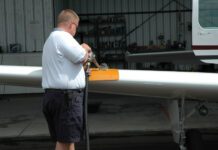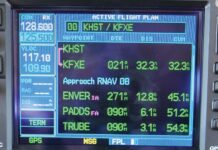The instrument-rated pilot of a Cessna 182S Skylane received an IFR clearance about 15 minutes prior to departure from Runway 18R. Witnesses reported observing the airplane pass directly over their work site at a very low altitude, about one mile south of the airport. Radar data disclosed that the airplane was airborne for about 1.5 minutes. Following departure, the airplane made a left bank to an easterly heading while gradually increasing its altitude to 1000 feet msl. The last two returns show an altitude of 900 feet msl and a slight change of direction back toward the south.

288
The departure clearance included a charted departure procedure that dictated continuing on the runway heading (180 degrees) until intercepting a VOR radial about six miles from the airport. Thereafter, the pilot was to make a left turn to join the radial and follow it to the first intersection on the departure route, about 10.25 miles south of the airport. Instead, the airplane impacted terrain in a near-level attitude with high forward velocity. There was no evidence of a pre-mishap mechanical malfunction or failure.
The accident occurred during darkness with a full moon. A Metar disclosed that at the time of the accident, there was an overcast cloud layer at 600 feet agl and 10 miles visibility. The pilot received an instrument competency check [now instrument proficiency check] several days prior to the accident and reportedly frequently flew with sole reference to the instruments.
The NTSB’s probable cause: “The instrument-rated pilot’s loss of situational awareness and failure to follow the prescribed instrument departure clearance/procedure, which resulted in an in-flight collision with the terrain.”
On an instrument clearance, it’s natural to assume we are fully protected when departing into IMC. Just like we are responsible to see and avoid other airplanes when flying in visual conditions even when flying IFR, however, pilots have certain responsibilities to avoid obstacles and terrain, even in IMC, when below or beyond radar coverage.
On an instrument arrival, we must fly charted approach segments and minimum altitudes. During an IFR takeoff, a safe departure climb path may be less clearly documented. How do you ensure you remain clear of obstacles during your initial climb to an airway or to minimum vectoring altitude? You use a published instrument departure procedure, that’s how. There are three basic types: standard, obstacle and roll-your-own.
SIDs
A standard instrument departure (SID) is a part of an instrument clearance that provides terrain clearance until the aircraft is on a published airway or other part of the en route structure, or above the minimum vectoring altitude (high enough for radar identification). Some SIDs are “pilot nav”—the departure equivalent of a full-procedure approach, with charted routes and altitudes from the ground to the en route structure. Other SIDs are radar SIDs, consisting of instructions to climb on a specific heading until radar identification, after which the controller will provide vectors to some fix. There are also some “hybrid” SIDs that include elements of both.
Although it’s been several years since this fatal crash, the pilot-nav SID assigned to the pilot remains in use, unchanged to this day. As noted in the NTSB report, the pilot was cleared to depart due south while maintaining a good rate of climb until intercepting a VOR radial to the southeast. He was then to climb on that southeasterly course for seven or eight miles (depending on how wind affected his ground track during the initial climb) and arrive at the point, LIZRD intersection, at 3000 feet. His clearance then took him east to CROIT intersection and then on a filed airway.
Despite properly reading back his clearance, the pilot turned southeast shortly after takeoff and impacted terrain a little more than three miles southeast of the airport. For some reason—disorientation, lack of familiarity with the procedure or willful disregard of his clearance—the pilot had planned the flight, but did not fly the plan. Precisely following a SID is as vital as following an approach procedure with precision. It takes the same level of briefing prior to flying the procedure, and it requires monitoring to ensure compliance with the charted procedure once airborne.
Obstacle Departures
What if the runway you’re using does not have a published SID? Before you launch blindly into the murk, check to see if there’s a published obstacle departure procedure (ODP) for the runway you’ll use. If there is, you’ll find it listed in the front of U.S. government approach plate books, and of course in the Jeppesen products as well. You may have to look them up online independently on a GPS or multifunction display electronic database (I use AOPA’s online Airports USA, clicking on Procedures and then Takeoff Minimums for the airport I’ll use. This takes me to the takeoff minimums/ODP section for the entire approach chart book that covers the airport I’ve selected). This is a good use of the iBooks capability of the iPad all pilots now seem to have: Access the approach chart books online and save then in a file in iBooks or some other app.
For example, I fly out of Beech Factory Airfield (KBEC) in Wichita, Kan. Despite Kansas’ deserved reputation for lack of terrain obstacles, there is a published ODP for departing KBEC to the north. Launching from Runway 1 in IMC, if given my release and “cleared on course,” I must climb on runway heading until reaching 2000 feet (more than 600 feet agl) before I can safely make my turn. Controllers are not required to give you this warning; you’re expected to have looked it up before flight.
The ODP publication also includes takeoff minimums, a statement of the required visibility and cloud clearance requirements for an IFR departure. In FAR 91.75, the FAA tells us that airplanes with two or fewer engines can only depart IFR if visibility is at least one statute mile. Of course, this does not apply to Part 91, or even Part 135 pilots, but it’s still a very good idea.
If terrain or other obstacles require, alternate takeoff minimums may be specified. Looking back at Beech Field’s Runway 1 departure, it calls for a 500-foot ceiling and one mile visibility if the pilot climbs at the standard obstacle clearance climb gradient of 152 feet per nm, in this case to 2000 feet msl. If the pilot can maintain at least 240 feet per nm to 2000 feet, he or she may launch with the lower, standard takeoff minimums.
How do you turn “feet per nautical mile” into a usable piece of information in the cockpit? The NOAA charts and Jeppesen guides also give us a table that permits comparing climb gradient to ground speed and deriving the rate of climb needed. For example, initial climb speed in the A36 Bonanzas I usually fly is close to 100 knots. With a typical headwind component, I can usually conservatively say I have a 90-knot groundspeed, though it’s often lower when heading into the Kansas winds. If for some reason I take off with a tailwind, I need to adjust my groundspeed accordingly. A standard climb gradient in this case is below the bottom of the chart, less than a very leisurely 300 fpm vertical speed. The 240 feet per nm needed to fly standard takeoff minimums according to the ODP document means I must climb at no less than about 360 fpm. That’s still easy in a Bonanza under most conditions, but it doesn’t give me room to experiment with significantly shallower climbouts or accelerating to a faster speed before establishing climb attitude. I can take off, but I’d better use the “book” takeoff and initial climb technique.
Experience has taught many pilots never to take off unless the visibility and ceiling are high enough to fly the approach in use at the time. Some will restrict themselves to taking off only when circling minimums for the approach exist at the time of departure. These are usually pilots who have experienced some problem launching into IMC and have survived to demand weather that gives them options. I listen to this kind of pilot and use the circling-minimums-for-takeoff rule myself. Among other things, this makes obstacle clearance much easier in the critical early stages of an instrument departure.
On Your Own
Are you taking off into IMC from an airport with no SID and no published ODP? You might relax because that suggests you have no obstacles to be concerned with. You still do, however, need to plan a way out that assured obstacle clearance. Take a moment to look at the sectional chart for the airport. If you don’t carry paper sectionals, you probably have them in an iPad or other electronic database, or at least can look at the vicinity of the airport in AOPA’s Airports USA online. Look for towers and hills around the area that might present a hazard. Don’t turn on course until reaching at least 400 feet agl; circling minimums for the runway in use is better if you have any obstacle concerns at all, and traffic pattern altitude is even better. Alternately, take off and climb in a hold directly over the airport—you know there are no obstacles there, and you can safely climb until radar identification or when you know it’s safe to proceed as cleared.
Just like “see and avoid,” any time in VMC, even on an instrument flight plan, pilots have a personal responsibility to avoid terrain and obstacles in the early stages of an instrument departure. It takes a little preflight research and study to determine a safe route for your climbout, and then precision and discipline to actually fly that route once you’re airborne.
But if you think about it, a departure is little more than an approach. You should prep and fly the departure just as you would an approach.



